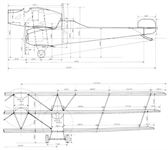P.Grosz, G.Haddow, P.Shiemer Austro-Hungarian Army Aircraft of World War One
Phonix 20.10
In response to the Kampflugzeug (battleplane) program of August 1914 (see Lloyd 40.06), Phonix submitted a proposal for a twin-engined biplane that, after further refinement, was approved by Flars in July 1915. Construction began in January 1916 and the completed aircraft, designated 20.10, was rolled out in September. The crew consisting of pilot and two gunners was housed in a narrow fuselage that had no provision for bombs. Two 200 hp Hiero engines were mounted on a framework independent of the wing structure and the fuselage was raised above the lower wing for aerodynamic reasons.
Test reports concerning the 20.10 prototype have not been found. Reviewing the program in December 1916, Flars could see no useful military function "for what was basically a 1914 design", but requested completion of modifications for purposes of testing and possible use as a trainer. Returned to the factory for installation of a strengthened undercarriage and rudders of increased area, the 20.10 was reported complete on 14 July 1917 and arrived at Aspern on 22 November 1917. Flight testing, if any, was of short duration, for in December the damaged prototype was placed in storage. The provisional order of 14 battleplanes, reduced from 24 in February 1916, was cancelled.
Phonix 20.11 and 20.12
The Phonix proposal for a triplane bomber configured to the Flars "large bomber program" guidelines (see Lloyd 40.08) was dated 3 March 1916. Phonix received a contract on 6 March 1916 to build two prototype bombers, designated 20.11 and 20.12. Designer Kirste had located the side fuselages between the lower wings, a more sensible approach than the awkwardly-placed fuselages of the Lloyd 40.08. At Flars' request to increase the field of fire, Kirste submitted an alternate layout with raised fuselages, but common sense prevailed and the original design was proceeded with - no doubt reflecting the lessons learned from the 40.08 ground tests. Construction of two bombers began in April 1916. Allowing work to continue on the 20.11 prototype, Flars however halted work on the 20.12 (nacelle and fuselages complete) in September 1916 and cancelled manufacturing plans by assigning the series 25 designation, originally reserved for the production bomber, to the Knoller C.I(Ph).
Construction of the 20.11 prototype went slowly. The final layout drawing dated February 1917 shows low side fuselages fitted with raised gunner's positions. A 300 hp Daimler V-12 pusher engine was mounted in the center nacelle and two 160 hp Daimler engines were installed in the side fuselages. A concerted effort to finish the 20.11 began in June 1917 but Flars, admitting its limited military value, cancelled the project in August, freeing Phonix to devote its energies to more important tasks. The unfinished 20.11 and 20.12 airframes were sent to the Eger depot in January 1918 for disposal.
Phonix 20.11 Specifications
Engine: 300 hp Daimler & 2 x 160 hp Daimler
Wing: Span Upper 24.00 m (78.74 ft)
Chord Upper 2.30 m (7.55 ft)
Chord Middle 2.30 m (7.55 ft)
Chord Lower 2.30 m (7.55 ft)
Gap Upper 1.50 m (4.92 ft)
Gap Lower 1.50 m (4.92 ft)
Total Wing Area ca 120 sq m (1291 sq ft)
General: Length 12.20 m (40.03 ft)
Empty Weight ca 2400 kg (5292 lb)
Loaded Weight ca 4800 kg (10,584 lb)
E.Hauke, W.Schroeder, B.Totschinger Die Flugzeuge der k.u.k. Luftfahrtruppe und Seeflieger 1914-1918
20. Flugzeuge der Phönix-Flugzeugwerke, vormals Österr. Albatros
20.10 Albatros DD 2 x H 200
20.11 Albatros Dr
20.12 Albatros Dr 2 x Dm 160, 1 x Dm 300
 |
P.Grosz, G.Haddow, P.Shiemer - Austro-Hungarian Army Aircraft of World War One /Flying Machines/
|
| The Phonix 20.10 battleplane prototype photographed at the factory in September 1916. The long propeller drive shafts allowed the designers to place the engines near the center of gravity. The forward fuselage section has been indented to clear the propellers.
|
 |
P.Grosz, G.Haddow, P.Shiemer - Austro-Hungarian Army Aircraft of World War One /Flying Machines/
|
| The just-completed Phonix 20.10 prior to being shipped to Aspern for test in late 1916. Photographs of the final version with reinforced undercarriage and larger rudders are not available.
|
 |
P.Grosz, G.Haddow, P.Shiemer - Austro-Hungarian Army Aircraft of World War One /Flying Machines/
|
| The busy Phonix prototype assembly shop in 1917. In the middle background is a Knoller C.I(Ph) under assembly. The workman on the high scaffolding is holding the propeller of the 20.11 bomber. A flying boat is under construction on the far right, behind which the Phonix C.I prototype can be seen.
|
 |
P.Grosz, G.Haddow, P.Shiemer - Austro-Hungarian Army Aircraft of World War One /Flying Machines/
|
| The Phonix 20.11 (or mock-up!) under construction in the Phonix factory. The height above the ground gives the impression that raised fuselages may have been considered at one time.
|
 |
P.Grosz, G.Haddow, P.Shiemer - Austro-Hungarian Army Aircraft of World War One /Flying Machines/
|
| Other than this photograph of the 200 hp Hiero inverted V-8 engine installed in the Phonix 20.02 prototype, no photographs of the prototype have been found. The outer fuselage of the Phonix 20.11 bomber, that was never completed, is in the left background.
|
 |
P.Grosz, G.Haddow, P.Shiemer - Austro-Hungarian Army Aircraft of World War One /Flying Machines/
|
| Project drawing of the Phonix 20.11 bomber prototype, signed by Kirste on 3 March 1916. Construction was started in April 1916 but the prototype was never completed.
|







